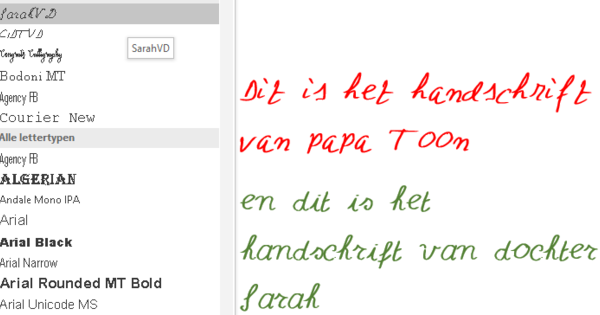Almost everyone knows that you can make charts in Excel, but not everyone dares to do it. Understandable, because with all those options and buttons it seems like a pretty complicated process. In reality it is not that bad, it is simply a matter of understanding how a graph works. In this article we will explain that to you and we will create some nice charts in Excel.
1 What is a chart?
A chart is a visual representation of, in this case, data in an Excel sheet. There are people who can easily estimate numbers in a series, but for most people it quickly becomes a hodgepodge of numbers. Graphs (also called diagrams, although that term is actually broader) are there to show that data in a way that makes certain things quickly clear. You can think of comparing numbers in a certain period (to see whether turnover decreases or increases) but also showing which percentage forms a number of a whole.

2 Different charts
There are countless ways to map numbers. Each type of graph has its own strengths. For example, one graph is only able to show one number series, while another graph makes it possible to compare different number series with each other. In this workshop we try to discuss as many graphs as possible to show you which graph you can use for what exactly.
Recommended charts?
In this workshop we will tell you exactly which graph you need to click to get a certain result. However, Microsoft Excel itself is very smart and can recommend a chart based on the data you select (you click on Insert / Recommended Charts). At the moment, however, we do not recommend that function yet, because it is very confusing if you do not yet know exactly which data to select and what exactly you are looking for in your chart. However, if you already know more about charts, this automatic Excel function can save you a lot of time and thinking.
3 Chart elements
Before we start working with graphs, it is useful to first know what exactly a graph consists of. As mentioned, every graph is different, but almost all graphs have certain elements. First, there is the graph area, which is the box in which everything related to the graph is displayed. The plot area is where the graph is 'drawn'. The data points are the parts that make up the chart (think of points in a pie chart). And then there are the legend and title, and possibly the horizontal and vertical values in the chart.

4 Templates
In this workshop we will make our own graphs. However, it is good to know that you do not always have to reinvent the wheel yourself. For example, you can also download templates via Excel, which you can then use to see exactly how a chart works. This gives you insight into how graphs work and by changing values you immediately see the effect. That way you can slowly but surely try to put together such a graph yourself. You can find the templates in Excel via File / New and then search for Graphs.

5 Determine data series
Before you can create a chart, there must of course be information on which to base that chart. In this article, we'll start with a basic data series that we'll adjust (or replace completely if necessary) depending on the type of chart we want to create. Let's take a football club as an example, for which we want to map out in which quarter the most contribution was paid. The graph should in any case contain the following values: contribution, the four quarters, the contribution paid per quarter and the total amount. Check out the image to see what this looks like in Excel.

Plain or 3D?
As you can read in this workshop, there are not only different types of charts, but you can also choose different options from one chart type. An option that almost all charts have in common is the option of 3D display. Unlike the other options, 3D doesn't change the layout of the chart itself, it just shows up in a nicer way. So there's nothing better or worse about a 2D or 3D chart, it's simply a matter of personal preference.
6 Pie chart
A pie chart, also called a pie chart or a pie chart, is a chart that makes it very easy to indicate which share of the total has a certain value. To make this chart, select all the values we entered in Excel, except the year total. Then click on Insert and then the circle icon next to the item Graphs. Choose 2D circle. The graph will now be inserted directly and clearly shows the proportions.

7 Format chart
The pie chart shows the legend below the chart, but you may prefer that the information is shown in the pie slices themselves. Or you would like to have the percentages mentioned. Fortunately, you can easily format the chart differently. When you double click on the chart, you will see in the ribbon in the tab To design the option Chart Styles. This allows you to easily choose from templates for the layout of your chart. In the ribbon you will also find other options, such as changing the colors, the layout and so on.

8 Circle of Circle
Our pie chart is not that complicated, because there are only four points. But suppose it is not four quarters, but 12 months (or worse, 52 weeks). Then certain pie slices suddenly become very small. In that case, choose under 2D circle at Insert / Graphs in front of Circle-of-circle. Excel will then remove a number of pie slices from the chart and display them in a sub-circle, so that the smaller pie slices can also be clearly visualized. The Bar-of-Circle option does the same, but not in a sub-circle, but sub-bar chart. This overview is not very useful for our example, but it can be useful in certain cases.

subgraphs
As you can see in step 8, in addition to the types of charts you can choose from, there are also subtypes, such as Circle-of-Circle. Many (but not all) charts that you can use in Excel have additional options such as grouping or stacking data. You will find a few more examples of this in this workshop. Again, one is not necessarily better than the other, some people find one view clearer, other people prefer another. It is a matter of trying it out (and also thinking 'outside yourself' when you present the data to someone else).

